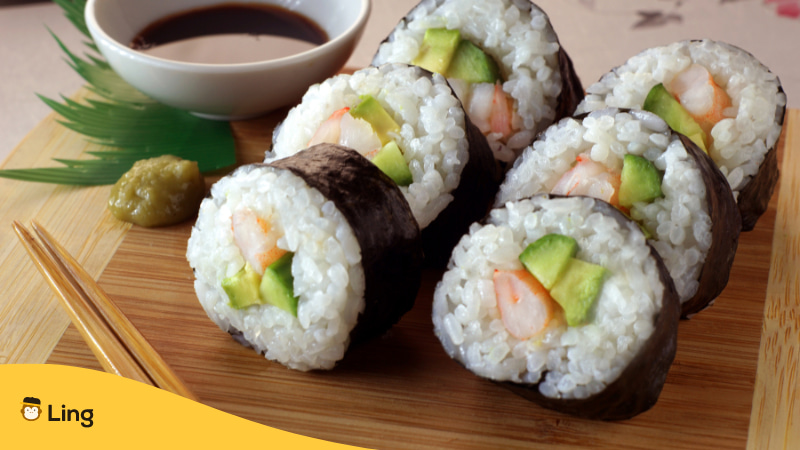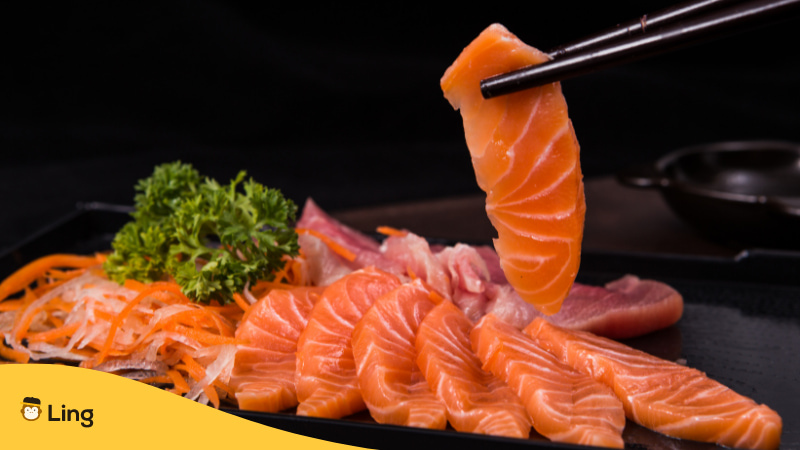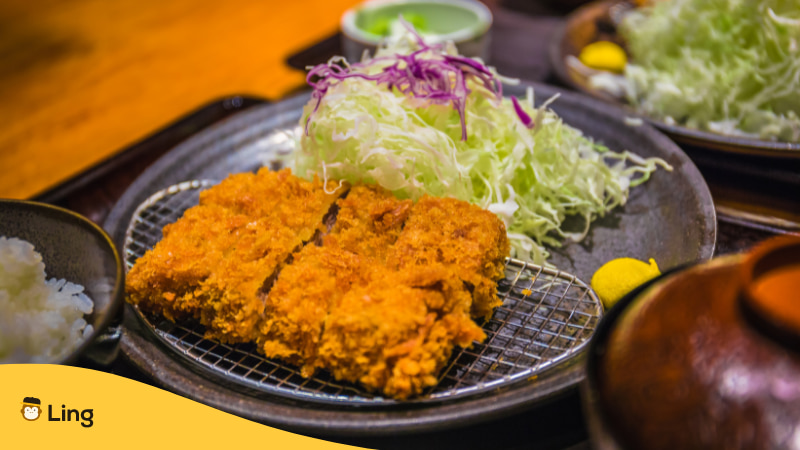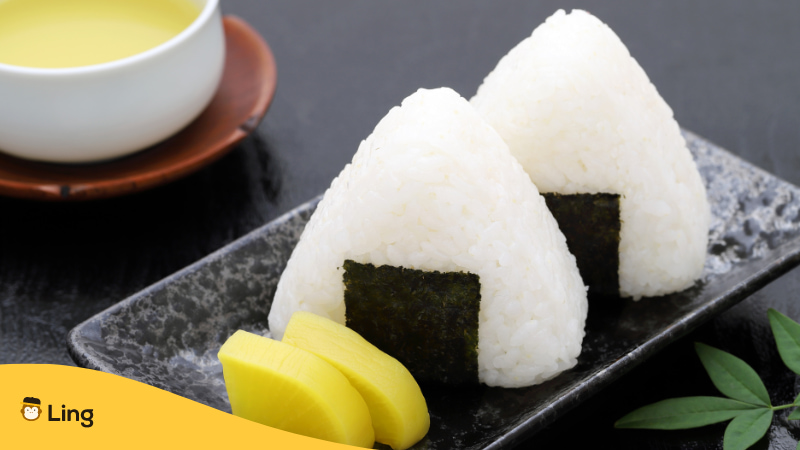Japan is an amazing country in every aspect, but today, can we talk about mind-blowing Japanese cuisine? Japanese cuisine offers an abundance of gastronomical delights with a boundless variety of regional and seasonal dishes.
We will have a chit-chat about those traditional Japanese foods and the main ingredients used in Japanese dishes in today’s Japanese blog post. Before getting into this post, you can also check our previous blog posts about Japanese foods if you like them as much as I do.
Luckily, Japanese restaurants are accessible all over the world now because you may want to feel the urge to try them and even learn Japanese after reading this post.
What Are Some Popular Japanese Dishes?
We gathered the most popular traditional Japanese dishes together in this post. From sushi rolls to wagashi desserts they all are unique delicacies. I was bursting to go to a Japanese restaurant while I was writing this post.
Let’s have a look at these tasty Japanese dishes below!

Sushi – 寿司
Sushi is one of the first things that comes to mind when we think about traditional Japanese food, and its popularity has been increasing for years around the world. Sushi is basically made with rice vinegar. There are various types of sushi but the most common ones can be counted as makizushi, nigiri sushi, and inarizushi.
There are also vegetarian sushi rolls which are usually filled with cucumber or avocado instead of seafood. You can find them in any Japanese restaurant.
Udon – うどん
Udon is one of the main noodle dishes eaten in Japan. Udon noodles are thick and chewy, and they are made from wheat flour. Udon can be served in different ways, but it is most commonly used in noodle soups, in which they are served in a savory soup with different vegetables.
Some of the most popular udon noodle soup dishes are kitsune udon, tempura udon, and chikara udon.

Ramen – 拉麺
Ramen is another popular noodle soup dish made from wheat noodles these noodles are also known as ramen noodles. Soy sauce, salt, miso, and pork bone are the four main ramen broth bases, and toppings include meat, boiled egg, and vegetables.
Ramen is one of the favorite dishes of Japanese people. That’s why it is widely available in restaurants and ramen bars, which are on almost every street corner in Japan. Also, Japanese ramen is so popular that we see it in literally every anime.
Tempura – 天ぷら
Tempura is made from pieces of meat and vegetables that are covered in a special tempura batter and deep-fried until they become crunchy and gold in color. Tempuras are usually made from either small shellfish like prawns, or vegetables like green beans, pumpkin, and sweet potato.
Tempura can be eaten by itself or served on top of rice bowls or noodle soups.
Miso Soup – 味噌汁
Miso soup is the most eaten food in Japan, almost every single day. It is made from a combination of miso paste and dashi broth. Miso soup is served as a side dish with traditional Japanese breakfasts, lunches, and dinners. To give the miso soup a little more taste, several toppings are added to it, such as green onion, wakame seaweed, and firm tofu.
Tofu – 豆腐
Tofu is soy milk that has been coagulated, with the resulting curds being pressed into blocks. These blocks come in differing levels of firmness and can be eaten raw, boiled, or fried.
Although tofu is mainly thought of in Western countries as a healthy food or vegetarian alternative, in Asian countries like Japan, tofu is enjoyed by everybody and is a common part of their traditional cuisine.
Yakitori – 焼き鳥
Yakitori means barbecued chicken. They are small skewers of bite-sized chicken pieces seasoned with salt or brushed with a sauce containing sake, a type of Japanese drink. There are many different types of yakitori, but the most common varieties are momo (chicken thigh), negima (chicken and spring onion), and tsukune (chicken meatballs).

Sashimi – 刺身
Sashimi is raw fish or meat that has been expertly cut into very thin slices, and it usually comes served with daikon radish, pickled ginger, wasabi, and soy sauce.
Sashimi differs from sushi in that all sushi is made with vinegared rice and does not always contain raw fish, while sashimi is almost exclusively raw fish and is never served with rice.
Donburi – 丼物
Donburi is a rice bowl dish that is almost as popular as ramen in Japan and a common lunchtime choice among Japanese workers. Donburi is made by preparing various meat, fish, and vegetables and serving with steamed rice in large bowls.
Natto – 納豆
This traditional Japanese food is made by fermenting soybeans in a special type of bacteria that is naturally produced in the human gastrointestinal tract. Natto has a strong smell similar to moldy cheese, as well as a sticky texture that some may find off-putting.
However, many other people love these fermented soybeans for their full-bodied, salty, and savory flavor and their ample nutritional value.
Oden – おでん
Oden is a dish that is consumed widely in wintertime. This hot pot dish is made by taking an assortment of vegetables and meats and stewing them in a light broth seasoned with soy sauce and dashi in a large hot pot at the center of a table. Diners can then scoop out their favorite pieces and enjoy their meals.
As well as being a hearty main meal, the delicious hot pot also serves as a communal heater on cold evenings.
Tamagoyaki – 卵焼き
A versatile delicacy that can be enjoyed for breakfast, lunch, or dinner, tamagoyaki means cooked egg. It is a Japanese omelet made by sequentially cooking and rolling up several layers of the beaten egg.
A freshly cooked tamagoyaki looks like a rolled-up crepe, which can then be sliced up and eaten by itself or used as a topping or filling in sushi.
Soba Noodles – そば
Soba means buckwheat in Japanese. It is one of the three main varieties of noodles that are most frequently eaten in Japan. Unlike udon and ramen; soba noodles are made from buckwheat flour. This gives them a slightly nutty flavor that works well with stronger flavors like garlic and sesame.
Soba can be served in soups with toppings of spring onions, agetama tempura flakes, kamaboko, and fish cakes.

Tonkatsu – 豚カツ
Tonkatsu pork is one of the Western-style foods (yoshoku) that were originally introduced to Japan by European people. Like most other yoshoku foods, the Japanese took the original tonkatsu and made it their own. Today, tonkatsu is made by coating pork chops in crisp panko breadcrumbs and deep-frying them until they are golden in color.
They are normally served in fruit-and-vegetable-based tonkatsu sauce with shredded cabbage and other crisp salad greens on the side. Tonkatsu is also often enjoyed as part of a bento-boxed lunch or as a sandwich filling.

Sukiyaki – すき焼き
Like Oden, sukiyaki is a Japanese hot pot dish commonly enjoyed during the winter. Sukiyaki hot pots are prepared by searing beef slices in the hot pot, then adding sukiyaki broth and different vegetables, noodles, and meats.
The name sukiyaki means to cook what you like, and the fun of making sukiyaki comes from being able to prepare the dish with your fellow diners, at the table, using whatever ingredients you want.
Okonomiyaki – お好み焼き
Okonomiyaki is made by mixing together butter, sliced cabbage, and other savory ingredients. Firstly, spoon the mixture onto a hot plate and then pan-frying as if you make a pancake.
Okonomiyaki originated in Osaka and Hiroshima, and its popularity spread to the rest of Japan over the years. There are also specialized okonomiyaki restaurants in Japan. In some of these restaurants, you are expected to prepare the okonomiyaki yourself, which makes for a delightfully fun cooking experience.

Onigiri – おにぎり
The onigiri is basically a rice ball and is the original portable food of Japan. Onigiri is portions of Japanese rice with a filling in the center, that has been molded into triangular shapes before being wrapped in nori seaweed. Popular onigiri fillings include umeboshi pickled plums, seasoned seaweed, tuna mayonnaise, and teriyaki chicken.
Takoyaki – たこ焼き
Takoyaki is also known as an octopus ball. This delicacy is cooked using a special hot plate with rows of half-spherical molds. Each of the molds is filled with a savory batter mixture before a bite-size piece of tako octopus meat is inserted into the middle. The takoyaki is turned with a pick every minute to ensure an evenly-cooked outside.
Takoyaki is typically served with a sweet or savory takoyaki sauce and topped with mayonnaise and katsuobushi bonito fish flakes.
Wagashi – 和菓子
The most authentic way to finish off a Japanese meal or matcha tea ceremony is by serving wagashi. Wagashi are basically traditional Japanese desserts, invented during the Edo period. Most wagashi are made using only a handful of ingredients, such as mochi rice cakes, anko paste, kanten, chestnuts, and sugar. The most popular wagashi include dango, daifuku, dorayaki, and yokan.
Some Vocabulary To Learn While Trying Japanese Foods
Enjoying Japanese culture is not just about watching Japanese drama or anime or embarking on its other cultural influences. You should also try learning the Japanese language yourself.
Here are some vocabulary related to Japanese foods to practice with your friend or by yourself.
Want to memorize these words and phrases better? Check out the Ling app! It has over 200 updated lessons to help you improve your writing, listening, speaking, and reading skills. And the best part is you can try it out for free! Get it from the App Store or Play Store now!
What Makes The Japanese Cuisine Special?
Japanese cuisine (和食-washoku) encompasses the regional and traditional foods of Japan, which have developed through centuries of political, economic, and social changes. The traditional cuisine of Japan is mainly based on rice, fish, and vegetables all of which can be cooked in various techniques.
It is based on combining the staple food, which is steamed 御飯 (gohan – steamed rice), with one or more okazu, “main” or “side” dishes. This may be accompanied by a clear or miso soup. The phrase 一汁三菜 (ichijū-sansai – one soup, three sides) refers to the makeup of a typical Japanese meal serving.
I recommend you read this post to learn more about local Japanese foods!
Want To Learn Japanese? Learn With The Ling App Now!
Do you want to learn Japanese, but you are unsure where to start? Well, the Ling app is an incredible platform that you must check out today!
The Ling app is a language learning app that includes the Japanese language as well as 60+ other languages. This app is not overwhelming to use, and you won’t need to commit many hours just to learn something new every day.
In fact, the Ling app is designed to save you time while learning languages, hence it has practical and concise lessons guaranteed to help you learn the Japanese language in 15 minutes per day!


























